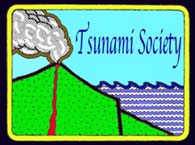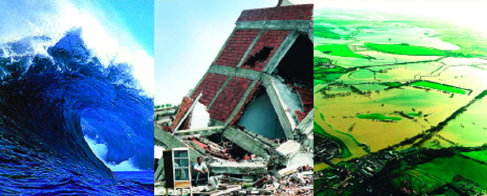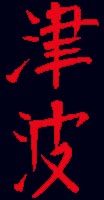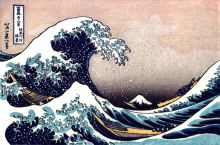ISSUES - Year 2011
ISSN 8755-6839
VOLUME
30, No. 1 (2011)
ABSTRACTS
for Volume 30, No 1
Complete Journal - STHVol30N1Y2011 (PDF Document 14.1 MB)
Journal in compressed format - STHVol30N1Y2011 (PDF Document 2.6 MB)
THE RESPONSE OF MONTEREY BAY TO THE 2010 CHILEAN EARTHQUAKE (1.9 MB) Compressed Version (460 KB)
Laurence C. Breaker - Moss Landing Marine Laboratories, Moss Landing, CALIFORNIA, USA
T. S. Murty - University of Ottawa, Ottawa, CANADA
Stephanie J. Flora - Moss Landing Marine Laboratories, Moss Landing, CALIFORNIA, USA
Craig N. Hunter - Moss Landing Marine Laboratories, Moss Landing, CALIFORNIA, USA
ABSTRACT
The primary frequencies contained in the arrival sequence produced by the tsunami from the Chilean earthquake of 2010 in Monterey Bay were extracted to determine the seiche modes that were produced. Singular Spectrum Analysis (SSA) and Ensemble Empirical Mode Decomposition (EEMD) were employed to extract the primary frequencies of interest. The wave train from the Chilean tsunami lasted for at least four days due to multipath arrivals that may not have included reflections from outside the bay but most likely did include secondary undulations, and energy trapping in the form of edge waves, inside the bay.
The SSA decomposition resolved oscillations with periods of 52-57, 34-35, 26-27, and 21-22 minutes, all frequencies that have been predicted and/or observed in previous studies. The EEMD decomposition detected oscillations with periods of 50-55 and 21-22 minutes. Periods in the range of 50-57 minutes varied due to measurement uncertainties but almost certainly correspond to the first longitudinal mode of oscillation for Monterey Bay, periods of 34-35 minutes correspond to the first transverse mode of oscillation that assumes a nodal line across the entrance of the bay, a period of 26-27 minutes, although previously observed, may not represent a fundamental oscillation, and a period of 21-22 minutes has been predicted and observed previously. A period of ~37 minutes, close to the period of 34-35 minutes, was generated by the Great Alaskan Earthquake of 1964 in Monterey Bay and most likely represents the same mode of oscillation. The tsunamis associated with the Great Alaskan Earthquake and the Chilean Earthquake both entered Monterey Bay but initially arrived outside the bay from opposite directions. Unlike the Great Alaskan Earthquake, however, which excited only one resonant mode inside the bay, the Chilean Earthquake excited several modes suggesting that the asymmetric shape of the entrance to Monterey Bay was an important factor and that the directions of the incoming tsunami-generated waves were most likely different.The results from SSA and EEMD produced results that differed. Although a period of 34-35 minutes was observed in the SSA, it was not detected in the EEMD. In previous comparisons, however, we have observed that oscillations detected in EEMD were not detected in SSA. SSA also revealed an oscillation with a period of 26-27 minutes, not observed in the EEMD. This oscillation, however, may not represent a fundamental mode but instead a harmonic related to the first longitudinal mode of oscillation whose period is ~55 minutes. We conclude that both methods were useful in helping to interpret the results of this study.
Keywords: Monterey Bay, 2010 Chile Earthquake, Bay Response, Great Alaska Earthquake, spectral decomposition
Science of Tsunami Hazards, Vol. 30, No. 1, page 1 (2011)
------------------------
THE TSUNAMIS OF JANUARY 3, 2009 IN INDONESIA AND OF JANUARY 15, 2009 IN SIMUSHIR AS RECORDED IN THE SOUTH KURIL ISLANDS (1.9 MB) Compressed Version (588 KB)
G.V. Shevchenko -Tsunami Lab, Inst. Marine Geology & Geophysics, Yuzhno-Sakhalinsk, RUSSIA
A.G. Chernov - Nyzniy Novgorod State Technical University, Nizniy Novgorod, RUSSIA
P.D. Kovalev - Wave Processes Lab, Inst. Marine Geology & Geophysics, Yuzhno-Sakhalinsk, RUSSIA
D.P. Kovalev - Inst. Marine Geology & Geophysics, Yuzhno-Sakhalinsk, RUSSIA
O.N. Likhacheva - Inst. Marine Geology & Geophysics, Yuzhno-Sakhalinsk, RUSSIA
A.V. Loskutov - Inst. Marine Geology & Geophysics, Yuzhno-Sakhalinsk, RUSSIA
A.A. Shishkin - Inst. Marine Geology & Geophysics, Yuzhno-Sakhalinsk, RUSSIA
ABSTRACT
Bottom pressure gauges installed by the Institute of Marine Geology & Geophysics RAS in Shikotan Island, Kitoviy Bay (Iturup Is.) and near Cape Van der Linde (Urup Is.), recorded two tsunamis during the month of January 2009. The first of the recorded tsunamis was generated by the January 3, 2009 earthquake in Indonesia and the second by the January 15, 2009 Simushir Island earthquake in the nearby seismic zone of the South Kuril Islands. The two tsunamis were additionally recorded by tide gauges at Hanasaki (Hokkaido Is.) and Malokurilskaya Bay (Shikotan Is.), but with considerable delay of the Indonesian tsunami from its estimated time of arrival. The tsunami travel time delay can be attributed to effects of energy trapping by Japan’s continental shelf. The maximum height of the Simushir tsunami (97 cm in the Kitoviy Bay) was also observed much later than the arrival of the first wave. Totally, the oscillations lasted for about 32 hours, which is very long time period for the relatively weak tsunami. The present study investigates these apparent anomalies of the
long wave oscillations and whether they were caused by reflected waves from the original earthquake or from a secondary tsunami generated by a weaker aftershock
Keywords: Tsunami, Earthquake, Indonesia, Kuril Islands, Urup, Iturup, Simushir, Shikotan, Hokkaido island, long wave spectral analysis, January 15, 2009 Simushir tsunami, January 3, 2009 Indonesia tsunami
Science of Tsunami Hazards, Vol. 30, No. 1, page 43 (2011).
------------------------
LOCAL SITE CONDITIONS INFLUENCING EARTHQUAKE INTENSITIES AND SECONDARY COLLATERAL IMPACTS IN THE SEA OF MARMARA REGION -
Application of Standardized Remote Sensing and GIS-Methods in Detecting Potentially Vulnerable Areas to Earthquakes, Tsunamis and Other Hazards. (7.6 MB) Compressed Version (376 KB)
George Pararas-Carayannis - Tsunami Society International, Honolulu, Hawaii, USA
Barbara Theilen-Willige - Technical University of Berlin, Institut für Angewandte Geowissenschaften, GERMANY
Helmut Wenzel - VCE Holding GmbH, Wien, AUSTRIA
ABSTRACT
The destructive earthquake that struck near the Gulf of Izmit along the North Anatolian fault in Northwest Turkey on August 17, 1999, not only generated a local tsunami that was destructive at Golcuk and other coastal cities in the eastern portion of the enclosed Sea of Marmara, but was also responsible for extensive damage from collateral hazards such as subsidence, landslides, ground liquefaction, soil amplifications, compaction and underwater slumping of unconsolidated sediments. This disaster brought attention in the need to identify in this highly populated region, local conditions that enhance earthquake intensities, tsunami run-up and other collateral disaster impacts. The focus of the present study is to illustrate briefly how standardized remote sensing techniques and GIS-methods can help detect areas that are potentially vulnerable, so that disaster mitigation strategies can be implemented more effectively. Apparently, local site conditions exacerbate earthquake intensities and collateral disaster destruction in the Marmara Sea region. However, using remote sensing data, the causal factors can be determined systematically. With proper evaluation of satellite imageries and digital topographic data, specific geomorphologic/topographic settings that enhance disaster impacts can be identified. With a systematic GIS approach - based on Digital Elevation Model (DEM) data - geomorphometric parameters that influence the local site conditions can be determined. Digital
elevation data, such as SRTM (Shuttle Radar Topography Mission, with 90m spatial resolution) and ASTER-data with 30m resolution, interpolated up to 15 m) is readily available. Areas with the steepest slopes can be identified from slope gradient maps. Areas with highest curvatures susceptible to landslides can be identified from curvature maps. Coastal areas below the 10 m elevation susceptible to tsunami inundation can be clearly delineated. Height level maps can also help locate topographic depressions, filled with recently formed sediments, which are often linked with higher groundwater tables. Such areas are particularly susceptible to higher earthquake intensities and damage. The sum of risk GIS factors increases the susceptibility of local soils in amplifying seismic ground motions. Areas most susceptible to higher earthquake impacts can be identified using a systematic GIS approach, the weighted–overlay-method implemented in ArcGIS. Finally, the data obtained by remote sensing can be converted into Google Earth-kml-format and become available at no cost, to raise public disaster awareness and preparedness in the Sea of Marmara region.
Keywords: Sea of Marmara, Bosporus, Dardanelles, 1999 Izmit earthquake, tsunami, landslides, remote sensing, GIS methods, Digital Elevation Model, Shuttle Radar Topography.
Science of Tsunami Hazards, Vol. 30, No. 1, page 63 (2011)
------------------------
--------------------------------------------
Copyright © 2011 - TSUNAMI SOCIETY INTERNATIONAL
TSUNAMI SOCIETY INTERNATIONAL, 1741 Ala Moana Blvd. #70, Honolulu, HI 96815, USA.
WWW.TSUNAMISOCIETY.ORG




